
LPG (liquid petroleum gas) used in kitchen gas cylinders is a mixture of propane and butane in diverse compositions. Even though LPG is essential for use in kitchens and the public is usually alert while using it, some additional safety measures need to be introduced
LPG used in cylinders (propane or butane) is highly combustible and poses a danger whenever it leaks from faulty equipment such as gas regulators, gas pipes/tubes, and other components of LPG gadgets/devices.
The gas tube that transports gas from the cylinder to the burner is generally the first to malfunction as it experiences the most damage/erosion at its joints.
We designed the Automatic LPG Gas Leakage Detection System using Arduino.
POC Video Tutorial In English:
POC Video Tutorial In Hindi:
Bill of Material
| Automatic LPG Gas Leakage Detection System – Parts List | |
| Components | Quantity |
| Arduino Uno (MOD1) | 1 |
| 12V, 2A adaptor | 1 |
| SIM900A GSM module (MOD2) | 1 |
| IC ULN2003 (IC1) | 1 |
| 5V relay (R1) | 1 |
| Buzzer (B1) | 1 |
| MQ6 or MQ2 sensor (S2) | 1 |
| MG996R high torque servo motor (S1) | 1 |
| Breadboard | 1 |
Blockages in the burner or defective regulators can also cause gas leaks. LPG is highly combustible when mixed with air.
When gas leaks inside a confined space, such as a house/kitchen, an explosion may occur if there is a source of ignition. Therefore, gas leakage is very dangerous.
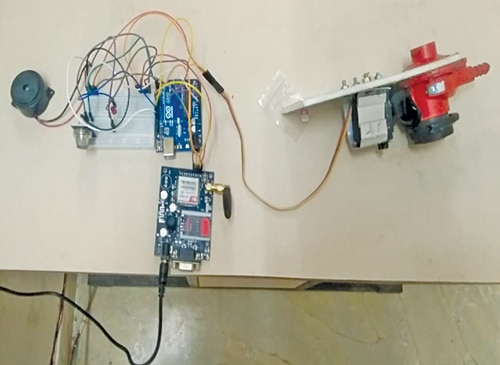
This project aims to protect homes/hotels/restaurants from the aforementioned problems and their adverse effects. The author’s prototype and the block diagram are shown in the respective figures. The required components for the project are listed in the Bill of Material table.
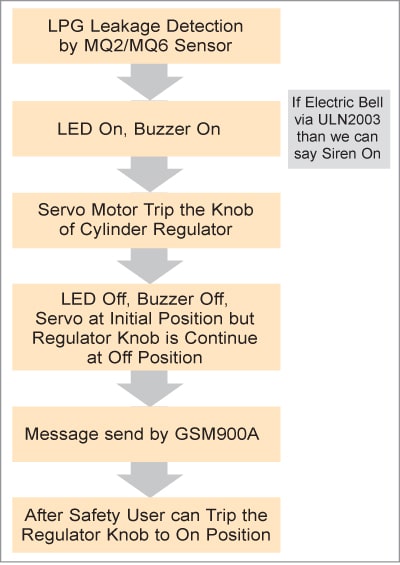
LPG Leakage Detection – Code
The Arduino IDE is used to create the code. In the code, first, include the SoftwareSerial library for interfacing the GSM module and then the servo library. Next, define variables for the PINs of the connected components.
After that, in the setup function, the serial is started with the default baud rate of the SIM9000A module. After completing other setup tasks, the loop function is created to check the LPG gas sensor status.
If the sensor detects gas, the message-sending function and servo function are activated. You can also add a buzzer or doorbell ring and other functions to the code that needs to be executed after detecting LPG gas leakage. Fig. 3 shows a source code snippet defining the pins.
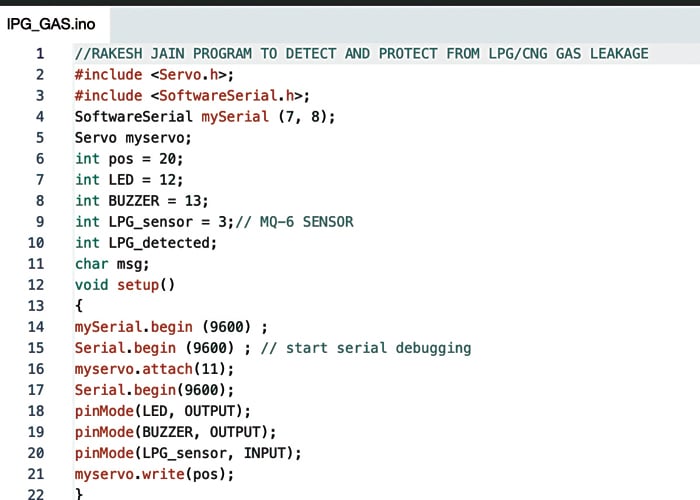
To upload the source code, select the correct COM port and Arduino board type, and then upload the code. After that, connect the components according to the circuit diagrams shown as in figures below.
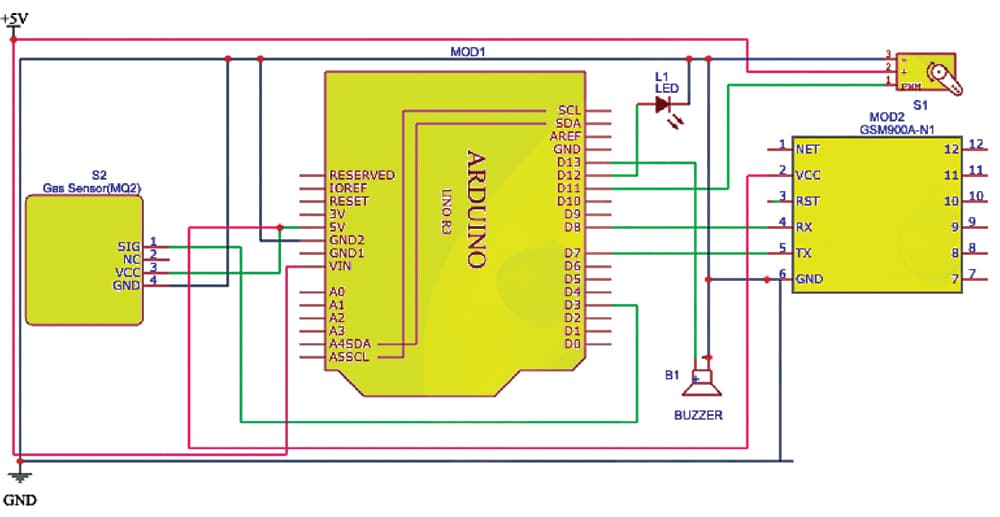
Circuit and Working
There are two circuits in this project. The first circuit is used with a buzzer and LED, as shown in Fig. 4, while the second circuit is used with a relay and relay driver IC ULN2003, as shown in Fig. 5. The source code for both projects is the same.
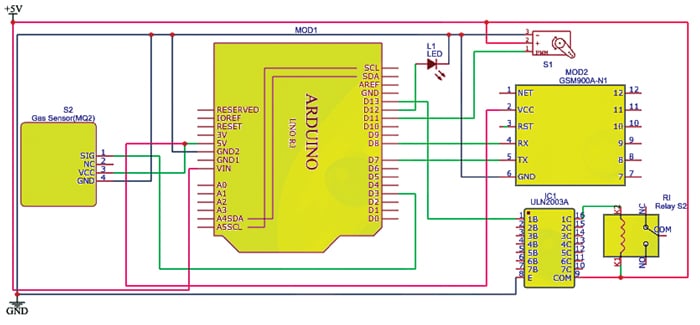
In this proposed project, we have interfaced Arduino Uno with MQ2/MQ6 sensors, SIM900A GSM module, servo motor, buzzer, and LED.
The interfacing is done in such a way that whenever there is a gas leak due to any fault, the MQ2/MQ6 gas sensor detects the leakage and sends a signal to Arduino Uno in the following manner:
- To drive the servo motor attached to the gas cylinder regulator, so that it immediately switches off the regulator automatically.
- To drive the SIM900A GSM module to send an alert message to a mobile number.
- To switch on the bell/siren as an alert.
Construction and Testing
Assemble the circuit on a breadboard or general-purpose PCB based on the circuit shown in Fig. 4 or Fig. 5. But do not forget to upload the source code into the Arduino Uno.
It would be better to refer to Fig. 6 and Fig. 7 before assembling to get an idea. Fig. 6 shows how the servo motor is attached to the valve.
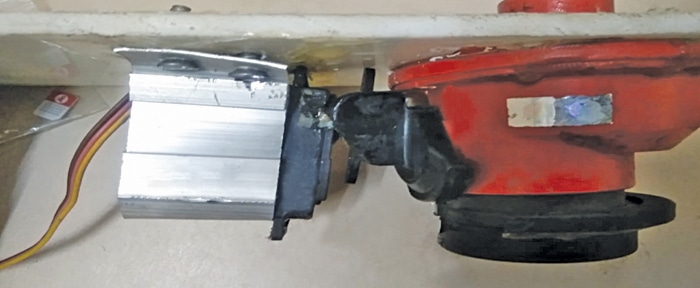
For testing, refer to Fig. 7. After uploading and assembling the components, power on the circuit, including Arduino and other components, using a 5V adaptor.
When gas leakage is detected, it automatically turns off the valve using the servo and then sends you a message while giving an alert using the buzzer and LED (buzzer sounds and LED glows).
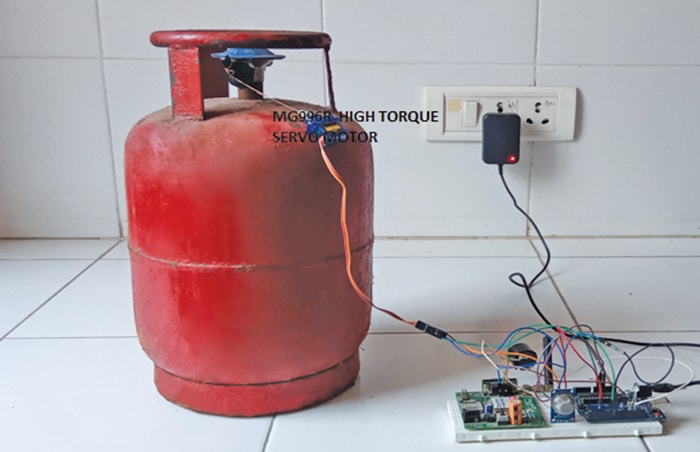
EFY note: Here we have used a buzzer and LED as an alert indicator, as shown in Fig. 4. But in Fig. 5, we have used the ULN2003 IC and an electric bell.
This project is very important for gas leakage safety purposes and definitely for the safety of life and property.
Check more such interesting Arduino Projects.
Advantages
- Detection of gas leakage
- Automatic tripping of the regulator knob to the off position, which can be reset by the user.
- Automatic indication and message facility.
Check other related Projects:
- Gas Leakage Alarm
- Smoke, Alcohol and LPG-Detection Alarm
- LPG Leakage Detector Without a Microcontroller
Rakesh Jain has a master’s degree in VLSI, BE degree in electronics and communication and a diploma in electronics. He is currently working as an Assistant Professor in the ECE department at Geetanjali Institute of Technical Studies, Udaipur. His research areas are microcontrollers and sensors, and he has to his credit 26 copyright and 3 Indian patents. He has also been honored with Mewar Scientist Award 2023







